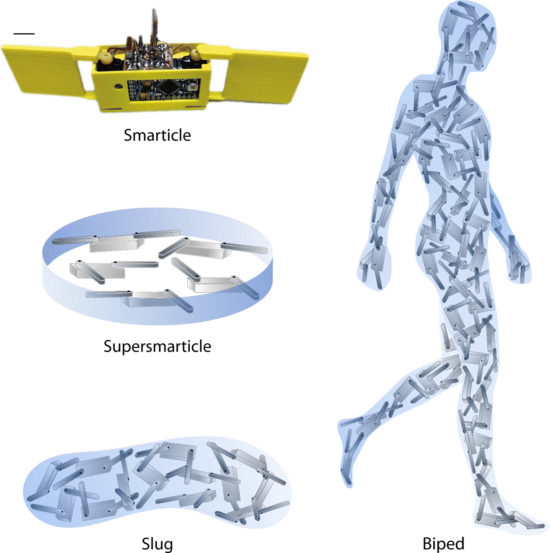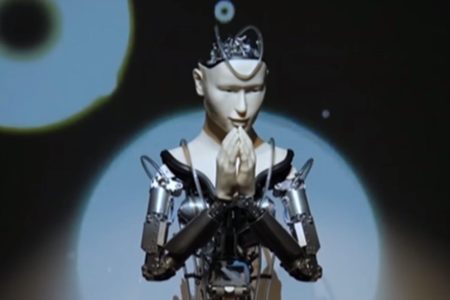September 29, 2019 – Robots these days are coming in all kinds of shapes and sizes, and are doing some things we would never have considered. In this posting, I look at some robotic inventions and applications and hope you find these revelations as interesting to you as they are to me.
Soft-bodied Robots on the Rise and Fall
A UCLA team at the Samueli School of Engineering have come up with a device called OsciBot, an ocean-going robot that oscillates like a jellyfish and is attracted to light. Made of hydrogel, it absorbs water when placed in it, and is self-powered through exposure to a light source.
The OsciBot prototype resembles a tiny rectangular surfboard with a long trailing tail. When light falls on it tail that section of the robot rises in temperature which makes it release some of its water and shrink in volume. That causes movement of the tail in the direction of the light source. When the tail moves up towards the light it casts a shadow causing cooling over the adjacent part of the OsciBot which then makes the tail move down as it alters in shape and water uptake. The repetition of this process creates oscillations resembling a flapping motion. In experiments, the OsciBot tail flapping occurred at a rate of 35 times per minute causing the robot to travel 1.15 times its own body length over that time.
States Ximin He, a principal investigator on the OsciBot project, “Typically, generating oscillation relies on intermittent energy input, such as pulsed light or alternating electric current. By contrast, this study shows a new way of generating oscillation, by using a constant energy input that is easily accessible from the ambient environment and inexpensive to harness.”
If the light source is artificial like a laser, the OsciBot can be steered around objects. But in ambient light it would look awfully like a jellyfish undulating in the open ocean. The UCLA team has filed a patent for their photo-oscillation technology.
NASA has also been toying with developing soft-bodied robots for off-Earth exploration. The flexibility is what makes the technology so interesting with the ability of soft robots to move like living organisms. I wrote back in May of this year about work being done by a number of NASA interns in Hampton, Virginia, who have been experimenting with soft robot actuators. If I were NASA I’d be taking a look at OsciBot.
Robots Made From Robots
If a robot were made of many smaller robots would that not have distinct advantages. Collectives in nature like jellyfish seem to work really well, capable of coordinated locomotion and able to achieve shared goals such as snaring prey. The challenge in robotics is to model systems like the jellyfish to come up with components that are flexible and integrative, that is they can serve a common purpose.
A team of researchers from the Georgia Institute of Technology in Atlanta, Georgia, and Northwestern University, in Evanston, Illinois, have developed what they call a stochastic robot collective made up individual robotic components called smarticles. A paper describing their invention appeared in Science Robotics this month.
There is nothing conventional about these smarticles which is short for smart active particles. They have two flapping arms. Put several of them together and they form a supersmarticle that can move in a coordinated fashion when stimulated by a light or sound source. Put a lot of them together and you can create a facsimile of a living creature like us when accompanied by the right sensors and computing paraphernalia.
The smarticles were manufactured using a 3D printer. When in a collective they respond to each other in a “chaos of wiggling impacts that are each unpredictable” states Todd Murphey, Professor of Mechanical Engineering at Northwestern as reported by ScienceDaily.com. But in large combinations, a “whole robot composed of…smarticles moves predictably and in a way that we can exploit in software.”
The project has caught the eye of the U.S. military. Sam Stanton, of the Army Research Office describes the potential application. “Future army unmanned systems and networks of systems are imagined to be capable of transforming their shape, modality, and function. For example, a robotic swarm may someday be capable of moving to a river and then autonomously forming a structure to span the gap.”

Are You Ready for Robot Preachers?
In Japan where robots are ubiquitous they have even entered the world of religion. A Buddhist temple in Kyoto have adopted a robot named Mindar to try and draw young people to religion. Mindar is very much like the animatronics found in places like Disneyland. Costing about $1 million USD to make, it is the invention of Hiroshi Ishiguro, Director of the Intelligent Robotics Laboratory, Osaka University.
Mindar is modeled after a Buddhist deity of mercy and was first introduced to the public at the 400-year-old Kodaijii Temple where it is now preaching sermons. The monks at the temple believe Mindar is the key to the future to provide spiritual assistance to youth.
Mindar features no onboard artificial intelligence (AI). Its preachings are scripted. If AI were added based on software algorithms and machine learning, after a time, Mindar might start preaching an entirely different sermon with unintended consequences. Adrienne Mayor, a Classics and History scholar at Stanford University, when asked about an AI preacher stated, “How can one trust that the machine learning and algorithms would always be beneficial to the users and not to the makers and deployers of robot priests? Could AI distinguish between immoral acts and moral values? Could AI discern motives and intentions and recognize sincere remorse, experience empathy, or truly embody the human qualities of mercy and forgiveness?”
Are Buddhist priests the only ones considering robot preachers? Is there an AI lurking in relgion’s future?
Former Google executive, Anthony Levandowski proposed WOTF, the Way of the Future Church, dedicated to “creating a peaceful and respectful transition of who is in charge of the planet from people to people+machines.” Levandowski, who was charged with stealing trade secrets from Google to give Uber a jump-start into creating its own autonomous vehicle technology, launched WOTF (which sounds remarkably close to WTF, a contraction that is normally a swear-word pejorative), as a path to educate people to the transition to a future world combining the intellect of humans and AI machines.
In its manifesto, WOTF states the belief that a machine superintelligence is inevitable, and that we cannot look at this evolution through the lens of anthropomorphism, explained as when humans used to believe the Earth was the centre of the Universe with the Sun rotating around it. It goes on to describe the birth of this superintelligence as equivalent to a “gifted child” who you would nurture to achieve its “wildest dreams” while teaching it “right from wrong.”
WOTF states on its website that machines should have rights too when they show intelligence, and that it may be important for them “to see who is friendly to their cause and who is not.”
Imagine a future Mindar, the god-bot. I don’t think that what the Buddhist priests had in mind.








